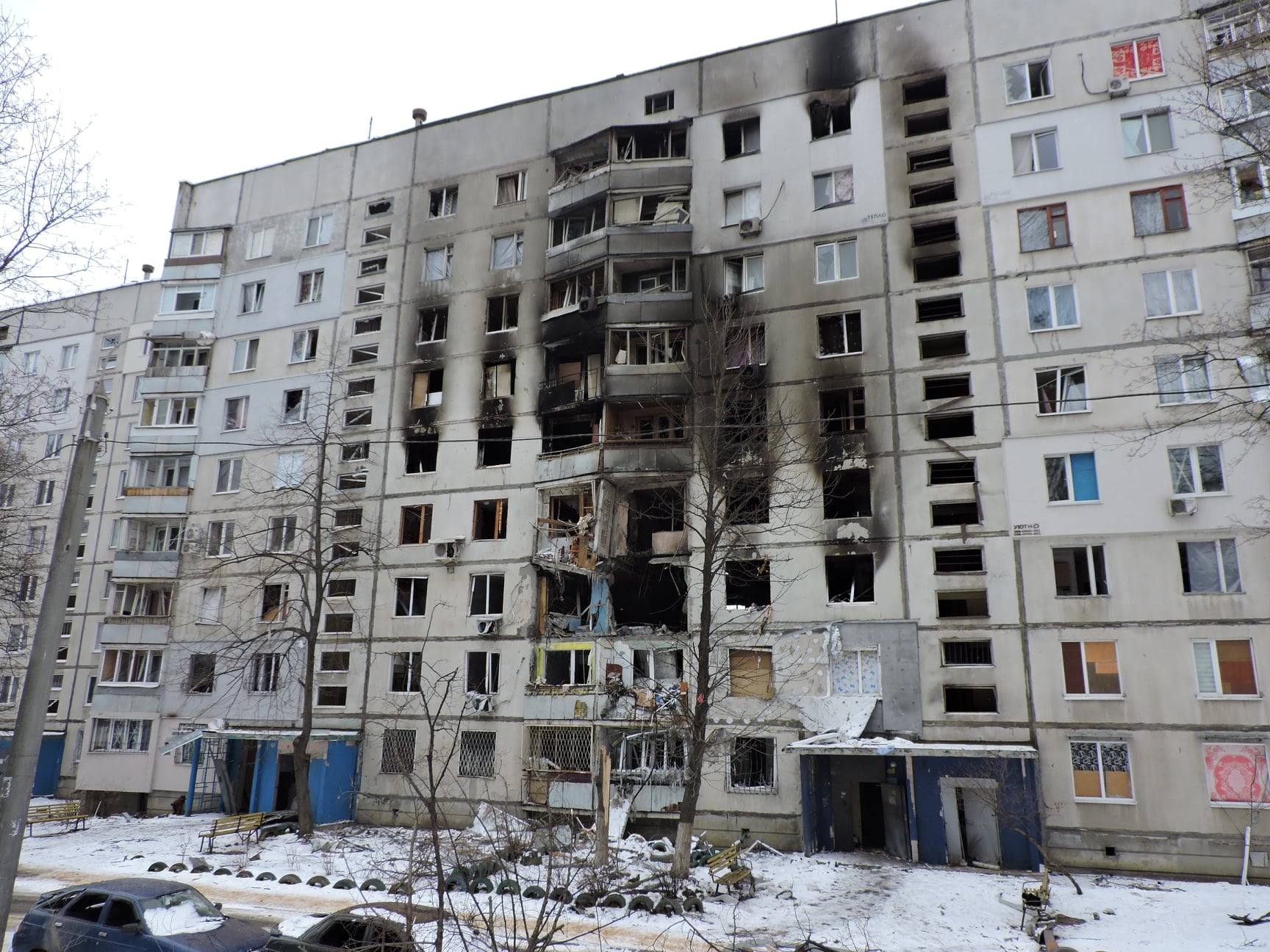By Serhiy Petrov
It was probably the hardest day for the city in the last week. The Muscovites’ shelling tended to subside (although not dependably) over the last four to six days, becoming less frequent and not as intense. But, this was a day of negotiations, and they were accompanied by a barrage of rocket fire and bombing. It’s become folk wisdom in Kharkiv to expect ruthless pounding whenever there are negotiations ongoing—done presumably to improve leverage in the bargaining.

More precisely, it all started at night, around 2 am, when the Muscovites began to pound. The shelling was intense since the early morning—more intense than it had been in the last week, or even 10 days.
Northern Saltivka and the microdistrict of Saltivka were shelled intensively, and they also started shelling Eastern Saltivka, in the neighborhood around Saltivs’ke Highway. Several hits were recorded there, damaging buildings and cars. In addition, a missile landed near the Russian Orthodox Church in Ukraine, located on the territory of the medical complex in the 602nd microdistrict (they almost hit it). The church is very close to a municipal perinatal center (maternity hospital #4). Maternity hospitals are a favored target for Muscovites, as are Russian Orthodox churches. The low-rise sector in Nemyshlya was also hit. In fact, I came under fire in that area while performing national-security duties. The bomb landed just a few blocks away from me. It’s hard to say how far exactly, but it’s something I saw personally. Nemyshlya was hit numerous times later as well.
The neighborhoods of Obriy, Rohan’, the Kharkiv Tractor Plant, and Novi Budynky were also heavily shelled. There is damage to residential buildings, cars, and the industrial gas plant (Kharkivsʹkyy Avtohennyy Zavod). Oleksiivka, Pavlove Pole, Pyatyhatky, the village of Zhukovsky, the Kharkiv Aviation Institute, and Kholodna Hora were all hit.
Presents from Moscow also landed in Gorky Park, also known as “Park of the Squirrel,” the former mayor Kernes’s most beloved legacy. In 2010, Gepa’s scum beat up activists who were protesting construction of the “Road of Death” (which went through the cemetery of WWII German soldiers) and mass removal of trees on both sides of the park. (Translator’s note: “Gepa” is the criminal nickname of Kharkiv’s former mayor Hennadiy Kernes.) It’s not a park I like to visit, but its shelling doesn’t make me happy..
The center of the city was hit by rocket fire, which damaged buildings on Svobody and Myronosytska streets. Windows of two of the closest buildings on the block were shattered. The shelling ruined the residential building at 8 Svobody Street, a modernist architecture monument built in 1911. The historical building is undoubtedly lost, because its entire central part, including slabs, was destroyed. Two people died under the rubble in the building. Based on the latest information, it appears to have been a blow by an Iskander missile from the Muscovite territory. Muscovites are turning the center of the city to ashes… The shelling was severe until about 4 pm and then began to subside. There were a few hours of silence after 6 pm. Apparently, the negotiations were over, and all the ammunition was spent. But, in the course of the evening, active shelling continued in other parts of the city. The Levada area of the city was hit. Oh yeah, the talks will continue tomorrow…
According to City Council information, about 600 houses have been damaged by shelling. Many of them are either completely destroyed or will have to be demolished, which is especially true for severely damaged and half-destroyed highrise buildings. There is no power in some of the arrears that were shelled, and networks cannot be repaired, because the shelling continues. Looks like this will be the case until the war ends… About 550 houses have lost heating, which can only be restored after the war. Unfortunately, this day once again reminded us that no district in the city is safe.
While some people have nowhere to go or cannot leave for various reasons, others remain in the city to fight, volunteer, work, perform other necessary tasks—or they’ve simply decided to stay until the end because Kharkiv is their home. I don’t want to sound overly dramatic, but there are people here who will never give up on Kharkiv!
I have some positive news as well. The network of assistance hubs run by the regional logistics center is expanding, primarily utilizing post office facilities. More and more districts of the city and suburbs are covered, including those that are occasionally shelled. People in Kharkiv are very cautious of everyone who takes photos and videos in their districts; they are making sure that “the wrong people” don’t take photos. There is a grassroots unification of Kharkiv residents on the neighborhood level. The city is not in despair, but absolutely infuriated with Muscovites. Captured Muscovite soldiers should be kept away from the locals, because they will rip them to shreds. Kharkiv stands and hangs on!
At the same time, shelling continued in Derhachi and Chuhuiv. There are many damaged private and administrative buildings in Derhachi. The community has problems with electricity and the residents are urged to minimize their energy use to help the impaired power network handle the load. A 15-year-old girl died from the shelling. In Chuhuiv, there was a shelling of a “military target”—it was a kindergarten and its surrounding area—and as a result, a 15-year-old boy died.
The most difficult situation is in Izyum, where the Muscovites made it impossible to bring in humanitarian aid or evacuate people. The fighting continues. The Muscovites tried to cross the Siverskyi Donets river but got kicked in the teeth. All the high areas of Kremenets are ours, which allows us to see the enemy tens of kilometers away. In addition, a minibus with people was shot up near Izyum.
Humanitarian aid managed to get through under the Muskovites’ fire in Balakliya and was being distributed to people today. The regional authorities are trying to deliver humanitarian aid to other towns and villages in the region (especially north of Kharkiv), which are occupied by Muskovites. It does not work everywhere unfortunately. Humanitarian aid has been delivered successfully to the Dergachiv city community settlements, except Kozacha Lopani and the surrounding area, on the very border where the Muscovite troops are based, because the Armed Forces of Ukraine edged them out there. This is very good!
There’s a difficult situation in the villages north of Tsyrkuni. There are food shortages, people are basically starving, and some are even eating the Muscovites’ leftovers just to stay alive. There have been incidents of forcible removal of people from these villages (it’s a sort of “evacuation,” to the pigs’ country) to Belgorod. Very little information comes out of there, because people aren’t being let out, and there is no stable connection. I do not know how to comment on this horror and Rushists’ actions. This is worse than Nazism. Rushism must be condemned by a tribunal and banned worldwide!
Muscovites are destroying agriculture equipment, especially in the Kharkiv region. This is done to prevent us from restoring agriculture after the victory. Scorched-earth tactics here, nothing new. They are simply not capable of anything else. The Rushists maimed many valuables in the Popov estate in Vasylivka, Zaporizhzhia Region. Some were stolen, including a 19th-century marble toilet. By the way, it had already been stolen once, by the Bolsheviks, during the invasion of Ukraine, but later the property was returned. In short, time goes by, and the Horde mentality is stable. Protests continue in the occupied cities of Kherson and Zaporizhzhia, despite repressions by Muscovite troops. Berdyansk, Melitopol, Kherson, and Nova Kakhovka—despite being occupied cities—still organize protests, and this is in spite of the abductions of regular people and activists. The kidnapped mayor of Melitopol, Ivan Fedorov, was taken to Luhansk, and in Berdyansk, the priest of OCU (editor’s note: The Orthodox Church of Ukraine), Oleg Nikolaev, disappeared as well.
Thanks to everyone who resists the occupier no matter what! The Darwin Award again goes to NATO air defense—particularly the Romanians, who failed to notice a Muscovite Orlan-10 UAV and let it fly 100 kilometers into their country. The Muscovites seem to be probing NATO’s intelligence capabilities and a potential missile strike. So far, NATO security is a matter of serious concern…
Congratulations to our military and defenders on this Volunteer Day! Thank you for what you are doing to protect Ukraine! Thank you to the Armed Forces of Ukraine, the National Guard of Ukraine, the Territorial Defense, volunteers, doctors, rescuers, and public utility workers for another day. Let’s help the army and support each other. We believe in ourselves, we believe in people, and we believe in Ukraine!
***
Translated by Oksana Kastanda Lamborn





